By Josh Volk
Originally published November 1, 2016.
Market growers have been adding radicchio and frisée to baby lettuce mixes for many years to add color and texture to salad mixes. More recently I’ve been seeing increased interest in full head production for these two members of the Cichorium genus. (Some pronuciation tips here - “c” when following “i” in Italian is usually pronounced like the “ch” in cheese, and counter intuitively to an English speaker “ch” followed by “o” is usually pronounced like the “c” in corn, “cch” is like the k in key.) Chicory (an English word, with standard English pronunciation rules) usually refers specifically to Cichorium intybus, the species that includes radicchio, sugarloaf, Belgian endive, as well as many others, but not frisée, escarole, or others of the Cichorium endivia species, the other main culinary species. Out of laziness, but also common production characteristics and common genus, I use the English term chicory to refer to all of the Cichorium species.
Chicories are in the family Asteraceae, which means they’re related to lettuce, as well as sunflowers. And chicories broadly share some production characteristics with lettuce, as well as some marketing and culinary niches. As I’ve gotten to know them better I’ve begun to realize how much broader their application is than that of lettuce, and I now see them as very complementary to lettuce production in terms of their seasonality here in the Northwest. From a field production standpoint, I slot chicories in the opposite season from lettuce. Being in the Northwest, with cool summers and cold, but only intermittently freezing winters, lettuce gives good harvests for me from mid-spring, through early-fall. Chicories start to come into their peak flavor as temperatures drop in the fall, and they are more hearty than lettuce, surviving occasional freezes well, and in fact sweetening over the course of winter. They also hold well in the cooler, much better than lettuce, especially when harvested slightly immature with an inch of root attached.
In their simplest form culinarily, they make excellent salads, but unlike lettuce they also hold up well to a variety of cooking methods, roasting being one of my favorites. There is great variation between varieties and different types, but all have some level of “bitterness” and “sweetness,” and the balance of the two can swing widely depending on the production method - especially influenced by temperatures during the harvesting season, and stresses on the plants.
Before 2004 I had grown a little radicchio and frisée, mostly not very well and then a fellow farmer introduced me to escarole - the gateway chicory.
Escarole is the most similar to lettuce in appearance and flavor, and in production. When I first started growing it I had a tough time finding more than one or two varieties, but now it’s possible to find at least a half dozen easily, and more if you look harder. There are variations in leaf size and shape and how upright the plants are, as well as how cold hardy they are, but generally escaroles look like a large head of green leaf lettuce and can be grown on similar spacing, tending to like a bit more room than leaf lettuce. I plant mine on pretty tight spacing, typically about 12”x12”, but for larger heads, and larger varieties, you might go as far apart as 18”x24” or wider. For me, escarole and other chicories follow lettuce, which I grow in the summer and early fall. I expect to do my first harvests in mid-October, just as my lettuce harvests are wrapping up. The weather is cooling down at that point and my experience is that harvesting any chicory in warmer weather increases the amount of bitterness.
Below, a planting of escarole shows the typical appearance that is similar to a looseleaf head of lettuce.
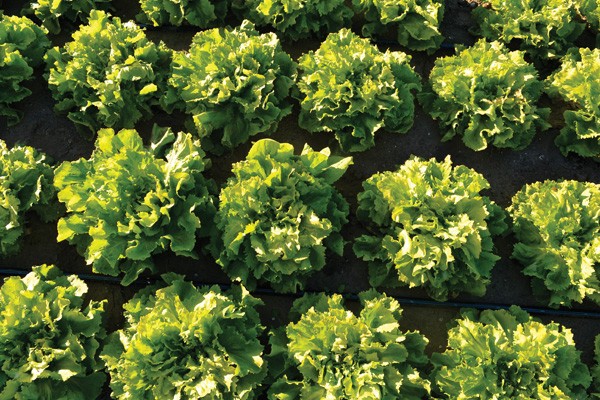
Escaroles can be very bitter in bad conditions (just as lettuces can be), but in the best conditions there is just a faint hint of bitter behind a lot of sweetness. My real revelation with Escarole was on a trip to northern Italy in November of 2006. Staying at a small vineyard outside of Sienna I had a very simple salad with escarole cut into fine ribbons dressed with a bit of lemon, freshly pressed olive oil and salt - still the best preparation I’ve had anywhere. One trick with the chicories to reduce the bitter and increase the sweetness and crunch in salads is to soak the leaves (cut or not) in ice water (or just cold water) for at least 10-20 minutes before dressing or cooking. Any cooking will also help reduce bitterness, but at some point you may come to enjoy and even crave the slight bitterness (or at least I do in the winter).
I grow escarole from transplants, similarly to lettuce. In Italy chicories are grown both from transplants and are direct seeded, depending on grower preference. Some people believe the direct seeded plants to be more cold hardy, and that’s likely true. I was told while I was in Italy that it is very important to not let the transplants get too big - only 3-4 weeks in seed flats. The plants can be quite small at that point, but they will take off once they get into the ground. This year I planted some that had leaves hardly 1/4” across with just a few long trailing roots and a month later they are big beautiful plants. For mid October harvests I seed all chicories in late June or early July, and for later harvests I’ll seed as late as mid-July, planting into mid August.
I know some growers who plant many successions and successfully (more or less) grow chicories through the summer and most of the winter. Chicories in general are prone to not only bitterness, but also bolting when the weather is warmer. Their more wild (than lettuce) tendencies show through in this weather, giving very uneven maturity and harvests when they are grown in less than optimal conditions. For the best results in warmer spring and early fall conditions, varieties that are faster to maturity (55-80 days) are the best choice.
These growing guidelines work pretty well for most of the chicories in my experience, not just escarole. Below are a few notes on other common and less-common types that I’ve grown.
Below, this planting of the frisée variety Bellesque shows how much more frilly it is than escarole. All photos by Josh Volk.
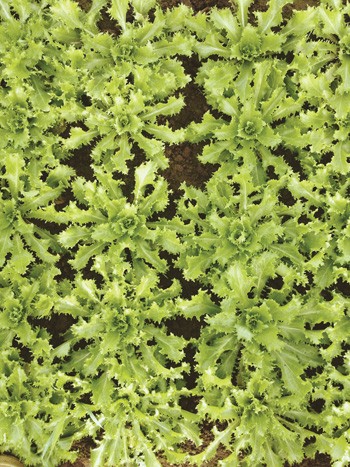
Frisée - I grow this very similarly to escarole. The blanched hearts of these heads are the real culinary treat and to blanch the heads there are numerous approaches possible. I’ve experimented with using a rubber band and tying the heads up about 5 days in advance of harvest, putting opaque plates on top of heads 5 days before harvest, and storing harvested heads in dark, but not cold conditions for 5 days after harvesting, before distributing. All of these work and each has its own issues. A lot of the modern varieties are somewhat self blanching, and I’ve mostly given up on the above methods, instead crowding the plants a bit so as they get large they push each other up, increasing the self blanching. This isn’t perfect, but it’s a lot less labor and space than the other methods.
Radicchio - There are two main types: Chioggia (round and red), and Treviso (oblong and red). The Chioggia is sometimes found in green, or speckled versions as well. I’m going to lump a few other types in here that don’t strictly belong, but are so similar that I hope the purists will forgive me. Both Chioggia and Treviso types are very recognizable, even here in the US, with pure white ribs and dark red to almost purple leaves. There are varieties of varying days to maturity from 55-130, allowing one to make a single planting and harvest over the course of many months (although that range of varieties is hard to find here in the US). The longer maturing varieties tend to be more cold tolerant, the shorter maturing more heat tolerant. There are also green varieties, and both Castelfranco and Lusia types are very similar to the red radicchio, but are green and red speckled. All of these start with a leaf shape and coloring that is nothing like the heads they will ultimately make, similar in some ways to butter lettuce, or cabbage.
Below, a mature head of Chioggia radicchio with the outer leaves pushed back to reveal the tight head.
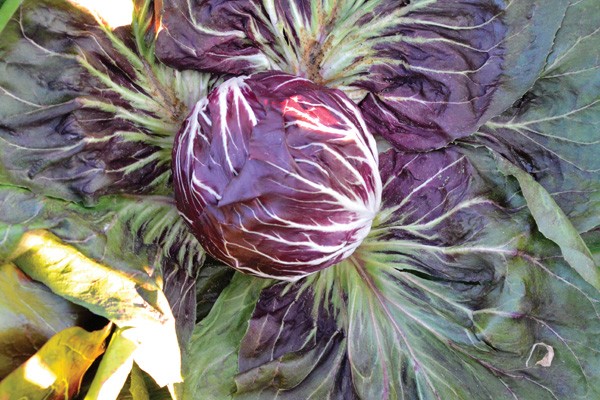
Sugarloaf (Pan di Zucchero) - This is a heading type similar in some ways to treviso radicchio, but light green and much, much larger, sometimes the size of a large baguette. It is one of the sweetest, least bitter chicories, and also least cold hardy. It’s great raw, but it’s also wonderful split in half longwise, drizzled with oil and salt and roasted or grilled.
Catalogna and Puntarelle - I lump these two together because they are basically two types of the same plant. Catalogna is harvested for the leaves and there are different leaf shapes, but basically this looks a lot like dandelion (a close relative). This is one of the less cold tolerant, and more bitter of the chicories, but it’s ribs can also be quite sweet and it is great in soups and stews, or just cooked on its own and dressed with a strongly sweet or salty dressing (think along the lines of a fig vinaigrette or anchovy dressing - these are also good on other chicories). Puntarelle is a type of Catalogna that is used for its flower stalks and is harvested at a very particular stage and prepared in a very particular way. It is typical of the region around Rome and grows best in similar conditions, but I see more folks succeeding with it here in the northwest so apparently it can be grown other places (I haven’t grown it successfully, it is very finicky).
Belgian Endive (Witloof) - This is a forcing chicory, meaning the roots are harvested, put into storage, and then warmed up to force leaves to grow in the dark, forming a tight, very pale head of leaves. I’ve had limited success with this one, and the seeding date needs to be earlier than other chicories in order to get a large root for harvest before the ground freezes. It also requires a warm, completely dark space where you can force the roots in the winter.
Below, a head of radicchio cut open to show the interior color.
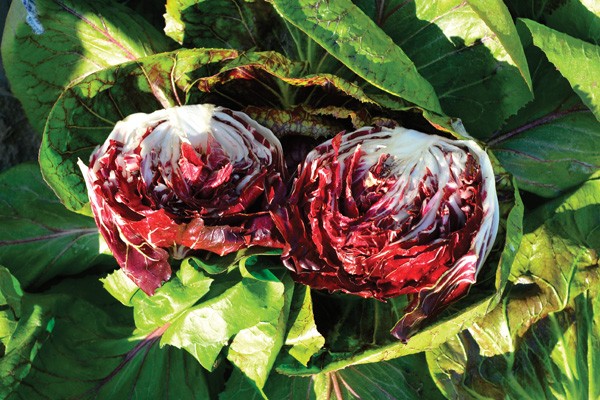
Tardivo - Similar to Belgian endive, this is one that is traditionally a forcing chicory, although it’s not harvested quite the same way. I’ve had limited success with this one, but I know a handful of growers who are making it work here in the US, and are growing beautiful heads. Look up “radicchio di treviso rosso tardivo” on Youtube if you want to see a great promotional video about production in Italy. Some growers are forgoing the forcing and just growing and harvesting it in the winter here in the Northwest. It has long strap leaves and has looser heads than other radicchios.
Grumolo - This is a type that produces florets. I’ve trialed it a few times, but with limited yields. It’s one of the more bitter types in my experience, but it is both beautiful and cold tolerant.
Below, a field of Treviso radicchio in Chioggia, Italy with a few other vegetables for the farmer (and to give a sense of scale).
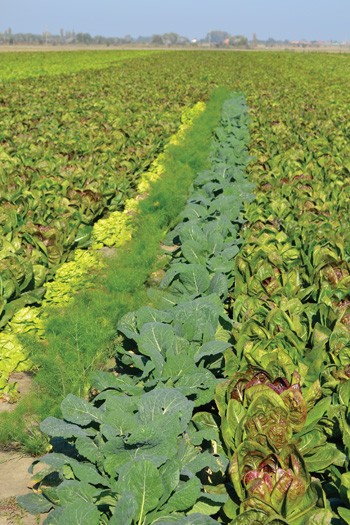
A few final notes
When harvesting chicories you’ll find that the cutting point is tighter than for lettuce, meaning if you cut too high the heads will fall apart, but if you cut too low you’ll end up with a lot of root. Nearly all of the types have many outer leaves that are best discarded due to toughness and bitterness. The hearts are the real treat, and the hearts can be big when grown well.
The biggest pest problem I have by far is voles. Deer come in a close second. The roots and hearts of these plants are like candy to them when it gets cold, and for good reason (the roots are actually very tasty roasted). I’ve had no problems with insect pests, and no more trouble with slugs than with any other crop. Rot can be a bit of an issue later in winter in our cold, wet conditions, but it usually works from the outside in, and leaves the heart untouched. I’ve harvested the most beautiful heads of radicchio out of what looked like a pile of slimy goo (not recommended - just saying it’s possible).
Chicories are a great crop, especially in the colder months. As demand grows I hope to see more variety availability, similar to what I’ve seen in Europe.
Josh Volk farms in Portland, Oregon, and does consulting and education under the name Slow Hand Farm. He is the author of the new book Compact Farms from Storey Press, available February 2017. He can be found at SlowHandFarm.com

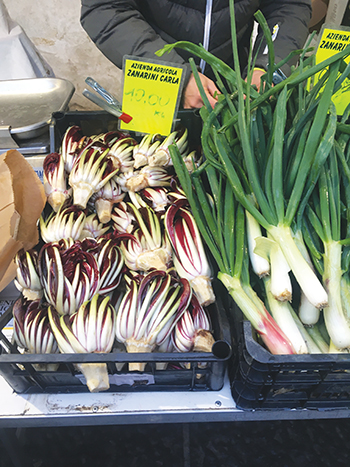 Plan now for a crop from stored roots next winter
Plan now for a crop from stored roots next winter